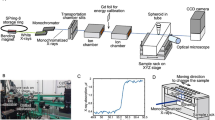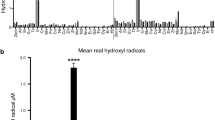Abstract
Core–inner-valence ionization of high-Z nanoparticle atomic clusters can de-excite electrons through various interatomic de-excitation processes, thereby leading to the ionization of both directly exposed atoms and adjacent neutral atoms within the nanoparticles, and to an enhancement in photon–electron emission, which is termed the nanoradiator effect. To investigate the nanoradiator-mediated dose enhancement in the radio-sensitizing of high-Z nanoparticles, the production of reactive oxygen species (ROS) was measured in a gadolinium oxide nanoparticle (Gd-oxide NP) solution under core–inner-valence excitation of Gd with either 50 keV monochromatic synchrotron X-rays or 45 MeV protons. This measurement was compared with either a radiation-only control or a gadolinium-chelate magnetic resonance imaging contrast agent solution containing equal amounts of gadolinium as the separate atomic species in which Gd–Gd interatomic de-excitations are absent. Ionization excitations followed by ROS measurements were performed on nanoparticle-loaded cells or aqueous solutions. Both photoexcitation and proton impact produced a dose-dependent enhancement in the production of ROS by a range of factors from 1.6 to 1.94 compared with the radiation-only control. Enhanced production of ROS, by a factor of 1.83, was observed from Gd-oxide NP atomic clusters compared with the Gd-chelate molecule, with a Gd concentration of 48 μg/mL in the core-level photon excitation, or by a factor of 1.82 under a Gd concentration of 12 μg/mL for the proton impact at 10 Gy (p < 0.02). The enhanced production of ROS in the irradiated nanoparticles suggests the potential for additional therapeutic dose enhancements in radiation treatment via the potent Gd–Gd interatomic de-excitation-driven nanoradiator effect.






Similar content being viewed by others
References
Averbukh V, Müller IB, Cederbaum LS (2004) Mechanism of interatomic Coulombic decay in clusters. Phys Rev Lett 93:263002–263006
Baluchamy S, Ravichandran P, Periyakaruppan A, Ramesh V, Hall JC, Zhang Y, Jejelowo O, Gridley DS, Wu H, Ramesh GT (2010) Induction of cell death through alteration of oxidants and antioxidants in lung epithelial cells exposed to high energy protons. J Biol Chem 285:24769–26774
Belkić D (2010) Review of theories on ionization in fast ion-atom collisions with prospects for application to hadron therapy. J Math Chem 47:1366–1419
Carter JD, Cheng NN, Qu Y, Suarez GD, Guo T (2007) Nanoscale energy deposition by X-ray absorbing nanostructures. J Phys Chem B 111:11622–11625
Cho SH (2005) Estimation of tumor dose enhancement due to gold nanoparticles during typical radiation treatments: a preliminary Monte Carlo study. Phys Med Biol 50:163–173
Choi G-H, Seo S-J, Kim K-H, Kim H-T, Park S-H, Lim J-H, Kim J-K (2012) Photon activated therapy (PAT) using monochromatic Synchrotron X-rays and iron oxide nanoparticles in a mouse tumor model: feasibility study of PAT for the treatment of superficial malignancy. Radiat Oncol 7:184–194
Dunford RW, Southworth SH, Ray D, Kanter EP, Krässig B, Young L, Arms DA, Dufresne EM, Walko DA, Vendrell O, Son S-K, Snatra R (2012) Evidence for interatomic Coulomb decay in Xe K-shell-vacancy decay of XeF2. Phys Rev A 86:033401–033412
Hainfeld JF, Slatkin DN, Smilowitz HM (2004) The use of gold nanoparticles to enhance radiotherapy in mice. Phys Med Biol 49:N309–N315
Hainfeld JF, Dilmanian FA, Slatkin DN, Smilowitz HM (2008) Radiotherapy enhancement with gold nanoparticles. J Pharm Pharmacol 60:977–985
Hergenhahn U (2011) Interatomic and intermolecular Coulombic decay: the early years. J Electron Spectrosc Relat Phenom 184:78–90
Hergenhahn U (2012) Production of low kinetic energy electrons and energetic ion pairs by intermolecular Coulombic decay. Int J Radiat Biol 88:871–883
Jahnke T (2004) Experimental observation of interatomic Coulombic decay in neon dimmers. Phys Rev Lett 93:163401–163404
Jahnke T (2015) Interatomic and intermolecular Coulombic decay: the coming of age story. J Phys B 48:082001–082010
Kalyanaraman B, Darley-Usmar V, Davis KJA, Dennery PA, Forman HJ, Grisham MB, Mann GE, Moore K, Jackson Roberts L II, Ischiropoulos H (2012) Measuring reactive oxygen and nitrogen species with fluorescent probes: challenges and limitations. Free Radic Biol Med 52:1–6
Kim J-K, Seo S-J, Kim K-H, Kim K-H, Kim T-J, Chung M-H, Kim K-RK, Yang T-K (2010) Therapeutic application of metallic nanoparticles combined with particle-induced x-ray emission effect. Nanotechnology 21:425102
Kim H-K, Titze J, Schöffler M, Trinter F, Waitz M, Voigtsberger J, Sann H, Meckel M, Stuck C, Lenz U, Odenweller M, Neumann N, Schössler Ullmann-Pfleger K, Ulrich B, Costa Fraga R, Petridis N, Metz D, Jung A, Grisenti R, Czasch A, Jagutzki O, Schmidt L, Jahnke T, Schmidt-Böcking H, Dörner R (2011) Enhanced production of low energy electrons by alpha particle impact. PNAS 108:11821–11824
Kim J-K, Seo S-J, Kim H-T, Kim K-H, Chung M-H, Kim K-R, Ye S-J (2012) Enhanced proton treatment in mouse tumors through proton irradiated nanoradiator effects on metallic nanoparticles. Phys Med Biol 57:8309–8323
Kreidi K, Jahnke T, Weber Th, Havermeier T, Liu X, Morisita Y, Schössler S, Schmidt LPH, Schöffler M, Odenweller M, Neumann N, Foucar L, Titze J, Ulrich B, Sturm F, Stuck C, Wallauer R, Voss S, Lauter I, Kim HK, Rudloff M, Fukuzawa H, Prümper G, Saito N, Ueda K, Czasch A, Jagutzki O, Schmidt-Böcking H, Stoychev S, Demekhin PV, Dörner R (2008) Relaxation processes following 1 s photoionization and Auger decay in Ne2. Phys Rev A 78:043422–043431
Le Duc G, Miladi I, Alric C, Mowat P, Bräuer-Krisch E, Bouchet A, Khalil E, Billotey C, Janier M, Lux F, Epicier T, Perriat P, Roux S, Tillement O (2011) Toward animage-guided microbeam radiation therapy using gadolinium-based nanoparticles. ACS Nano 5:9566–9574
Lechtman E, Chattopadhyay N, Cai Z, Mashouf S, Reilly R, Pignol JP (2011) Implications on clinical scenario of gold nanoparticle radiosensitization in regards to photon energy, nanoparticle size, concentration and location. Phys Med Biol 56:4631–4647
Leung MKK, Chow JCL, Chithrani BD, Lee MJ, Oms B, Jaffray DA (2011) Irradiation of gold nanoparticles by X-rays: Monte Carlo simulation of dose enhancements and spatial properties of secondary electrons production. Med Phys 38:1–8
Luchette M, Korideck H, Makrigiorgos M, Tillement O, Berbeco R (2014) Radiation dose enhancement of gadolinium-based AGuIX nanoparticles on HeLa cells. Nanomed Nanotechnol Biol Med 10:1751–1755
Matthew JAD, Komninos Y (1975) Transition rates for interatomic auger processes. Surf Sci 53:716–725
Miladi I, Aloy MT, Armandy E, Mowat P, Kryza D, Magné N, Tillement O, Lux F, Billotey C, Janier M, Rodriguez-Lafrasse C (2014) Combining ultrasmall gadolinium-based nanoparticles with photon irradiation overcomes radioresistance of head and neck squamous cell carcinoma. Nanomed Nanotechnol Biol Med. doi:10.1016/j.nano.2014.06.013
Misawa M, Takahashi J (2011) Generation of reactive oxygen species induced by gold nanoparticles under x-ray and UV irradiations. Nanomed Nanotecnol Biol Med 7:604–614
Mohan S, Koyoma K, Thangasamy A, Nakano H, Glickman RD, Mohan N (2007) Low shear stress preferentially enhances IKK activity through selective sources of ROS for persistent activation of NF-B in endothelial cells. Am J Physiol Cell Physiol 292:C362–C371
Polf JC, Bronk LF, Driessen WHP, Arap W, Pasqualini R, Michael Gillin M (2011) Enhanced relative biological effectiveness of proton radiotherapy in tumor cells with internalized gold nanoparticles. Appl Phys Lett 98:193702
Porcel E, Liehn S, Remita H, Usami N, Kobayashi K, Furusawa Y, Le Sech C, Lacombe S (2010) Platinum nanoparticles: a promising material for future cancer therapy? Nanotechnology 21:085103
Porcel E, Tillement O, Lux F, Mowat P, Usami N, Kobayashi K, Furusawa Y, Le Sech C, Li S, Lacombe S (2014) Gadolinium-based nanoparticles to improve the hadrontherapy performances. Nanomed Nanotechnol Biol Med 10:1601–1608
Pradhan AK, Nahar SN, Montenegro M, Yu Y, Zhang HL, Sur C, Mrozik M, Pitzer RM (2009) Resonant X-ray enhancement of the auger effect in high-Z atoms, molecules, and nanoparticles: potential biomedical applications. J Phys Chem A 113:12356–12363
Qin Y, Lu M, Gong X (2008) Dihydrorhodamine 123 is superior to 2,7-dichlorodihydrofluorescein diacetate and dihydrorhodamine 6G in detecting intracellular hydrogen peroxide in tumor cells. Cell Biol Int 32:224–228
Schatz T, Cook AR, Meisel D (1999) Capture of charge carriers at the silica nanoparticle/water interface. J Phys Chem B 103:10209–10213
Sisourat N, Kryzhevoi NV, Kolorenč P, Scheit S, Jahnke T, Cederbaum LS (2010) Ultralong-range energy transfer by interatomic Coulombic decay in an extreme quantum system. Nat Phys 6:508–511
Stolterfoht N (1988) Electronic process in ion-atom collisions. In: Berényi D, Hock G (eds) Lecture notes in physics 294. Springer, Berlin, pp 3–36
Acknowledgments
The authors greatly thank Prof. Reinhard Dörner at Goethe University, Germany, for the discussion about interatomic Coulomb decay in ionized nanoparticles and its potential relevance to the nanoradiator effect. This work was performed with financial support from the Basic Science Research Program, International Corporation Foundation Establishment Program and Atomic energy research expansion program through the National Research Foundation of Korea funded by the Ministry of Education, Science and Technology (20090088454, 2012M2A7A1026636, 2013M2B2B1075774). This work was also partially supported by research Grants (20115004) from the Catholic University of Daegu in 2012.
Author information
Authors and Affiliations
Corresponding author
Rights and permissions
About this article
Cite this article
Seo, SJ., Han, SM., Cho, JH. et al. Enhanced production of reactive oxygen species by gadolinium oxide nanoparticles under core–inner-shell excitation by proton or monochromatic X-ray irradiation: implication of the contribution from the interatomic de-excitation-mediated nanoradiator effect to dose enhancement. Radiat Environ Biophys 54, 423–431 (2015). https://doi.org/10.1007/s00411-015-0612-7
Received:
Accepted:
Published:
Issue Date:
DOI: https://doi.org/10.1007/s00411-015-0612-7




